Gloucestershire Volunteer Artillery
Introduction
Many of the records of the artillery of Bristol were lost or destroyed during World War 1. The work of collecting and compiling the records of the unit from its formation carried out in the 1931 by Serjeant Major, Instructor In Gunnery, Brigade Regimental Serjeant Major, F. Healy from the official war diaries filed in the record office and from notes news cuttings and publications. Major J. Smith RA (V) MBE TD wrote the article "The Bristol Gunner Tradition." Derek Driscoll put both articles on his "The Bristol Gunner" website and this page is based on that.
As Major Smith wrote, "Regrettably a comprehensive history of the Volunteer Artillery Movement in Bristol has yet to be written. The task of unraveling the kaleidoscope of amalgamations that went to produce the ancestry of the present Gloucestershire Volunteer Artillery unit needs more investigation to make it complete. The following is intended as a starting point for further research in the future."
19th Century
In September 1859, a circular letter was sent by Lord the secretary Lord Palmerston, the secretary of state for war, to the Lord Lieutenants of candidates to the effect that the government had expressed a decided preference for artillery rather than rifle Corps in maritime neighbourhoods. The Lord Lieutenant of Gloucester the (the Earl of Ducie) thereupon addressed a letter to the Mayor of Bristol, in answer to a requisition made to him by Mr Hirst and others, who had expressed of their willingness to enrol themselves in an Artillery Corps. Informing him that the formation of an artillery Corps with headquarters in Bristol would not only receive official sanction, but would be considered a valuable adjacent to the volunteer force already established.
Major Henry Bourchier Osborne Savile, then Major of the newly formed Rifle Corps, was selected by the Lords Lieutenant of Gloucestershire and Somerset to raise the Artillery Corps of these counties. The Major was made Major Commandant of the new Artillery Corps on 21 December 1859 and which which he commanded for fourteen years retiring in 1874 and then served the Corps as the Honorary Colonel.
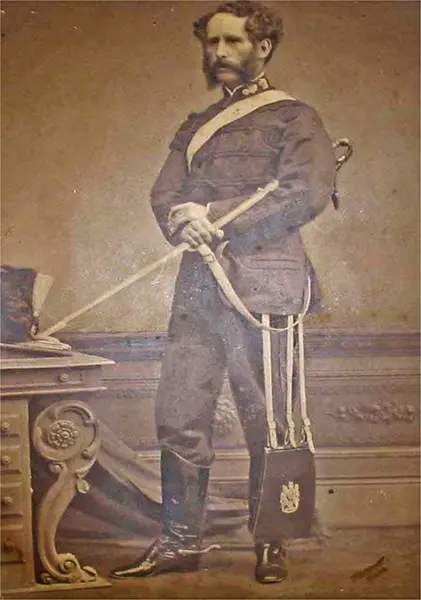
Colonel Henry Bourchier Osborne Savile
On the 22 November 1859, the Gloucestershire Volunteer Artillery (GVA) was formed, making it's headquarters at the Artillery Ground, Whiteladies Rd. Clifton, Bristol. The unit started with five batteries with a sixth added later. The GVA were tasked with the defence of the Bristol Channel and the ports of Bristol and Gloucester and were fully paid for and organised by the City of Bristol, it was not part of the War Office responsibilities. The motto of the GVA is 'Fidus et Audax', which is Latin, meaning 'Loyal and Audacious.' It was chosen by the original officers of the GVA as values to be aspired to by everyone who serves in the GVA. History has shown that The Bristol Gunners have never failed to live up to these ideals.
In May 1860, the newly formed Gloucestershire Artillery Volunteers were fortunately able to secure a long lease from the Society of Merchant Venturers of the existing parade ground on Whiteladies Road, Clifton, Bristol, and an appeal was made to the public for funds for the construction of an armoury, sheds and stores at a cost of £1,100, while a Drill Hall was added in 1895, at a further cost of £1,200. They received four 18 pounder smooth bore guns from the War Office which were installed on the old Avon Battery site at Avonmouth on 21 July 1860, and used for firing practice at a sea target. Earthworks were also built and used in connection with ball practice. In April 1860, Sidney Herbert, the Secretary for War, had informed the Town Clerk of Bristol that the War Office intended to restore the old battery at Portishead Point for the protection of Bristol. The site was purchased from Richard Bright in 1864, re-roofed, the magazines repaired, and two platforms installed for the two ton 32 pounders, the Gloucestershire Artillery Volunteers finally taking possession of their new practice ground on 23 October 1865.
The newly formed artillery corps on May 15., 1860, appointed William McAdam from the Royal Artillery, as captain and adjutant and their surgeon as A.G. Power, late of S.A.S. [we are not certain what this was].
| Battery | Captain | 1st Lieutenant | 2nd Lieutenant |
| No. 1 | Henry Grant | Francis Tothill | H. L. Bean |
| No. 2 | F. P. Egerton | Sholto Vere Hare | G. Garrard |
| No. 3 | J. Battersby-Harford | F. Walker-Savage | Gore Langton |
| No. 4 | W. Montague Baillie | Charles D. Cave | St. Vincent Ames |
As well as the above officers each battery also had four Sergeants, four Corporals, three trumpeters, and 75 men.
The following is an extract from "The Rules Bristol and Gloucestershire Artillery Corps 1859"
That each member absent from either of the parades fixed by the commanding officer, at the time of roll call, shall be fined sixpence; and if absent during the all time of the parade, one shilling; if absent from the commanding officers parade, the fines shall be double; who shall talk, or laugh, or misbehave whilst on parade or under arms, for each offence sixpence; who shall come on parade not uniformly dressed or accoutred after the first muster or after being attached to his company 14 days, one shilling.
Each member quitting the parade without the leaves of that superior officer present, five shillings. N. C. O's and gunners shall for this disobedience of any order, or other disrespectful conduct towards an officer whilst on duty or under arms, for the first offence such some not exceeding 10 shillings, as the commanding officer in his discretion shall inflict.
When not on actual service, service members could quit the Corps by giving 14 days notice.
Officers paid an annual subscription of three guineas, and other ranks an annual subscription of one guinea and each member had to find his own clothing, arms and accoutrements which had to be in accordance with the prescribed patterns.
A band was formed and supported by donation and voluntary subscription, officers of the Corps paid an annual subscription of £2, 2 shillings.
Fees of honour were paid by officers on an appointment to the clerk of the peace as follows: Major £30, Captain £20, Lieutenant £10, Second Lieutenant £5 pounds as well as an entrance fee of five guineas and the annual subscription of three guineas, or a donation of £20.
General Sir Richard Dacres, obtained the grant of four 18 pounder smooth bore guns for the Corps whilst commandant at Woolwich. These guns were originally intended for the Crimea. The guns arrived at Bristol on 26 April 1860, in the Brig "Nautilius" at the quay near Prince Street Bridge and where escorted to the enclosure in front of the Victoria Rooms by the Queen Charlton Troop of the North Somerset Yeomanry under Captain Haviland, the Bristol rifles under Lieutenant-Colonel Bush and the Bath rifles under Captain Ford. In the evening a Banquet which was attended by 500 was given in the Victoria rooms.
On 21 July 1860, the four 18 pounder, smooth bore guns were removed to Avonmouth, and fired for the first time. On 23 July, Her Majesty showed her a first public recognition of the volunteer movement by holding a grand review of the force in Hyde Park, at which the Gloucestershire Artillery was represented by a large proportion of the members.
A fifth battery was added on 8 Augsut 1860
18 September 1860, there was a review at Gloucester at which the Corps was present.
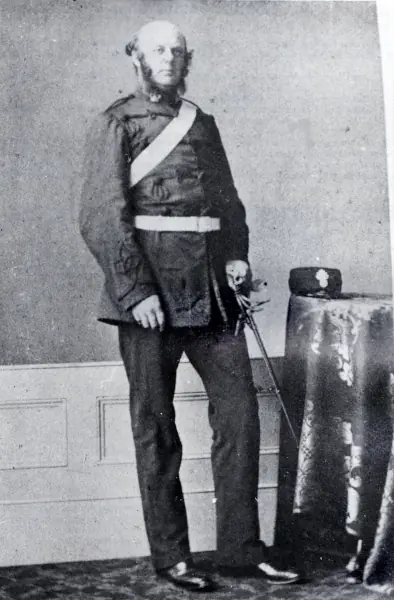
Captain Hare, Gloucestershire Volunteer Artillery, 1860
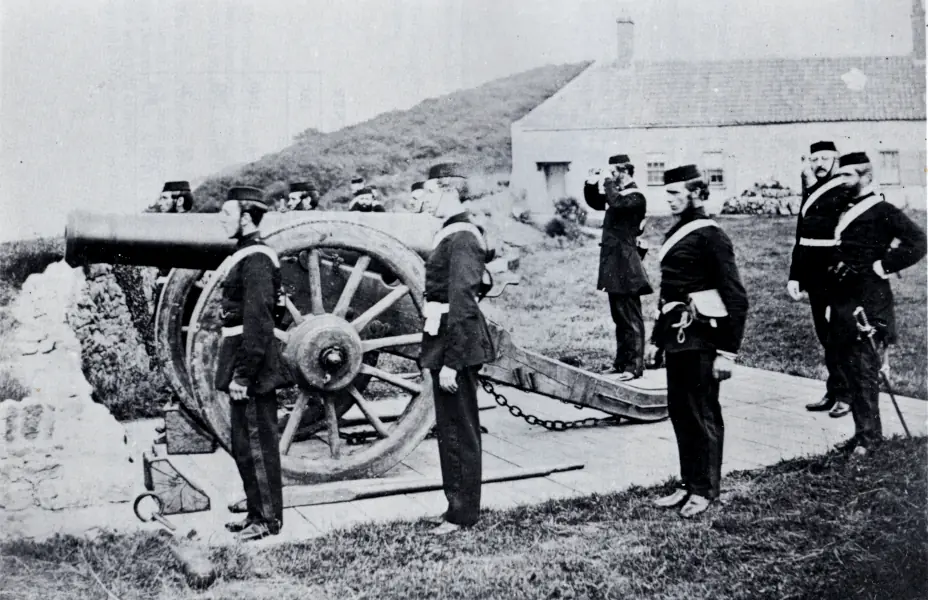
Captain Hansom's Battery, Gloucestershire Volunteer Artillery, 1860
16 December 1861, there was a presentation of a testimonial to Major Savile.
On 23 December 1861, the Corps attended a funeral service held at the Cathedral in memory of the late Prince Consort. There was also a review at Warwick at which the Corps was present.
17 June 1862, there was a review of about 10,000 volunteers which was held on Durdham Downs, in which the Corps took part. The restoration of the surface of the Downs was not achieved quickly. The Downs Committee instructed Captain A. M. Jones (later Colonel Arthur Mowbray Jones (1823-1889) of Ringwood House, Pembroke Road, Adjutant of 1st Gloucestershire Regiment and Secretary of the Review Committee to fill holes left by the grandstand in September 1862.
In November 1863, the 1st (Clevedon) Somerset Artillery Corps, the No 2 (Newham) and No 3 Gloucestershire Artillery Corps was formed with the Bristol Corps into an Administrative Brigade and was designated 1st Administrative Brigade and Gloucestershire Artillery Volunteers.
Also in 1863, the Bristol ladies by subscription procured Two Whitworth 3 pounder guns, and presented them to the Corps. The drill Hall was added at a further cost of £12,000 - being built to the plans of Mr C. F. Rumney a member of the Corps, and was opened on the 10 March 1865.
From October 1871, until July 1874, except for a short spell on Dartmoor in late July and early August 1873, 'K' Battery, 4 Brigade, Royal Artillery were at Horfield Barracks, Bristol, and in July of both 1872 and 1873 they availed themselves of the facilities at Portishead.
In October 1872, the 6th battery was formed at Clifton.
In March 1880, the Gloucestershire Volunteer Artillery had become the 1st Gloucestershire Artillery Volunteers (Gloucester and Somerset).
The first administrative Brigade was consolidated into a single Corps with headquarters at Bristol, and designated the 1st Gloucestershire Artillery Volunteer Corps. The Corps consisted of 720 all ranks and distributed in nine batteries as follows:-
Batteries Nos. 1 to 6 at Clifton
Battery No. 7 at Newham
Battery No. 8 at Gloucester
Battery No. 9 at Clevedon
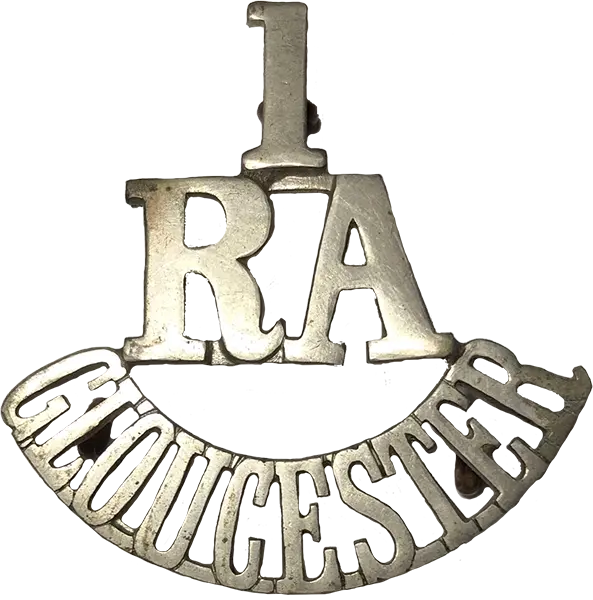
1 RA Gloucester pre 1908 white metal shoulder title shoulder title
In 1881, the 1st Gloucestershire Artillery Volunteers moved their range from Portishead to Clevedon to have the benefits of a land range, but the practice battery at old battery remained intact until 1899 when the buildings at Portishead were finally demolished and the 64 pounder rifled, muzzle loading (RML) guns by then installed returned to stores.
On 7 March 1863, the Corps attended in Hyde Park on the occasion of the public entry of the Princess Alexandra into London.
On 10 March 1863, on the occasion of the marriage of H.R.H. the Prince of Wales to the Princess Alexandra a letter addressed to the commanding all officer by order of the secretary of state for war.
[No Date shown]
V/G.A.
Sir, - I am directed like Col Mc Murdo, C.B. to convey to you, the officers, and non-commissioned officers, and gunners of the first Gloucestershire Volunteer Artillery Corps, the thanks of the Rt Hon Secretary of state for war from the high standard of efficiency which the Corps is reported to have attained.
I have the honour to be, Sir,
Your obedient servant, J. S. F. Dick, Major.
Assistant Inspector.
To Major Savile,
Commanding 1st Gloucestershire Artillery volunteers, Bristol.
Also on 10 March, the guns of the Corps fired a Royal Salute on Durdham Down.
24 June 1863, there was a review at Oxford at which the Corps was present.
22 August 1863, two Whitworth guns purchased by private subscription were presented to the Corps.
On 28 November 1863, the Newham, Gloucester and Clevedon Corps were formed into an administrative Brigade with the Bristol Corps. Major Savile appointed to the command of the Brigade with the rank of Lt. Col. Lord Glentworth Late of the rifle Brigade, was appointed Major of the Brigade.
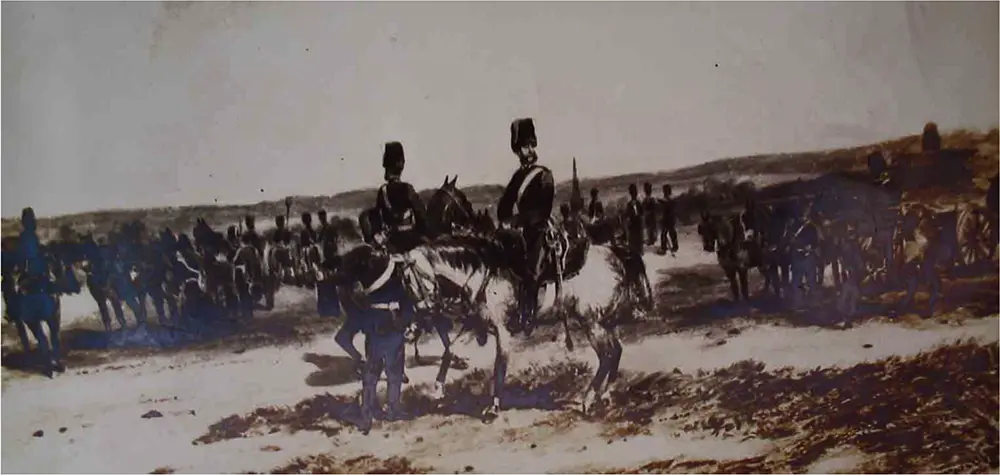
1st Gloucestershire Artillery Volunteers in 1863
Far left is Lt. Bean, Captain and Adjtutant McAdam. Standing, Captain Tothill, Lt. Col. Savile, on the far right Lt. Hanson
On 28 May 1864, there was a review in Hyde Park, at which the Corps was represented.
9 December 1864 - The Corps created a demonstration at the opening of the Clifton Suspension Bridge, and fired a Salute.
18 March 1865 - The Drill Hall at headquarters was opened.
3 May 1865 - Lord Glentworth appointed Major Commandant of the 1st Corps.
29 May 1865 - The practice range was removed from Avonmouth and established at Portishead for a land range.
30 July 1865 - A Bazaar and Fantasy Fair was held at headquarters in aid of the building fund of the Corps.
2 August 1865 - A review at Wells, at which the field guns were present.
25 July 1866 A Review and Sham Fight at Lansdown, in which the Corps with its guns took part.
5 June 1867 - The Earl of Limerick resigned the rank of Major Commandant of the 1st Corps. Lieutenant. Col. Savile reverted to the command of the 1st Corps, in addition to that of the Brigade.
17 August 1867 - A Sham Fight at Cadbury Camp at which the Corps was present.
13 April 1868 - A Review and Sham fight took place at Portsmouth at which the Corps was present.
September 1868 - Mr. Midwinter appointed Bandmaster.
31 October 1868 - Captain C. D. Cave Esq. appointed Major of the Brigade in succession to the Earl of Limerick who had resigned.
30 January 1869 - Major C. D. Cave Esq. appointed Major of the 1st. Corps in succession to the Lieut. Col. Savile who had resigned.
29 March, 1869 - The Clevedon Battery fire a volley at the opening of Clevedon pier
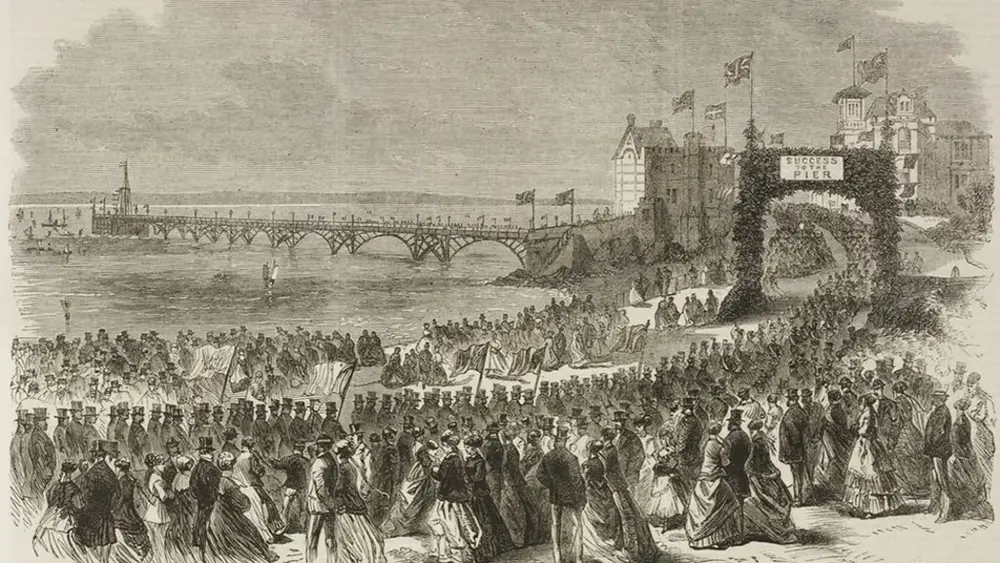
The opening of Clevedon Pier, 29 March 1869
Photo: Illustrated London News, 10 April 1869 via BBC News
19 June 1869 - A Sham fight at Almondsbury; the hill being defended by the guns of the Corps.
August 1870 - Detachment attended the N.A.A. a camp at Shoeburyness.
1871 - Officers examined for Certificates of Proficiency.
28 April 1871 - F. Bacon Esq., late R.M.A. appointed Major of the first Corps in succession to Major Cave who had resigned.
31 May 1871 - Camp formed at Portishead.
In October 1872, 'F' battery (later known at No. Six Company) was raised by Captain W. M. Webb, who was posted to the command of it. The Whitfield Field guns (the private property of the Corps) were transferred to this company which was worked for a time at a field battery. The company obtained many of its members from amongst the students at the University College and the medical school, the legal profession, the banks and insurance companies this company provided many officers for the Corps in later years.
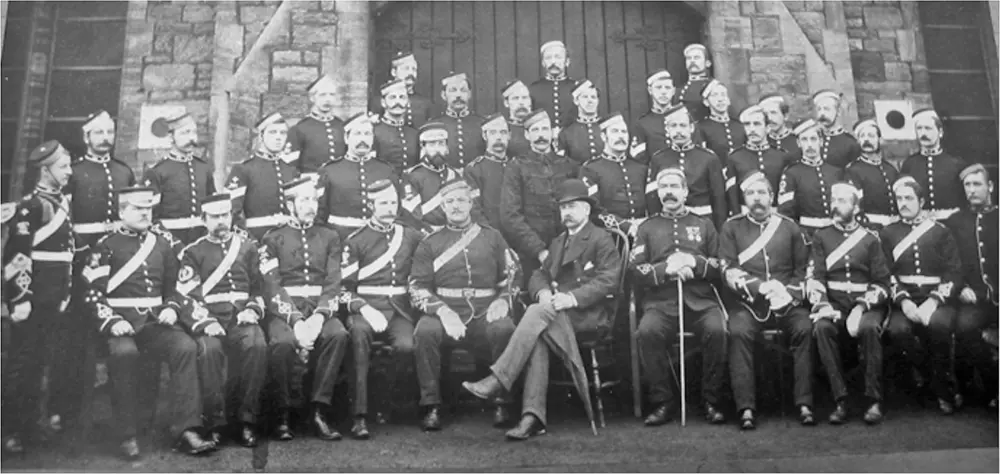
W.O.s and Staff Sgts and Sgts mess (Col. A. Versturme in civilian cloths)
Notes on the above photo: The badges of rank worn by the front rank, also the handlebar moustaches and the beard of one man who wears the rank of Sgt, who along with two other men wears a peak hat,(front row assume to be regulars) the others wear a pillbox hat. The man directly behind the Colonel in the picture is wearing an officers dark blue uniform. The Adjutant perhaps?. He has four lines of cord? decoration on the front of his jacket, so he is a Captain.
20 January 1872 - Sham fight at Portishead, and attack of the battery.
27 February 1872 - The Corps attended a Thanks Giving Service at Clifton Church on the recovery of H. R. H. the Prince of Wales.
1 April 1872 - Breech loading (BL) carbines first issued to the Corps.
11 August 1872 - Two detachments attended the National Artillery Association camp at Shoeburyness.
25 September 25 1872 - Major Bacon redesigned his rank in the 1st. Corps.
October 1872 - The formation of a 6th battery sanctioned by the Secretary of State for War.
15 January 15 1873 - Colonel Blunt R.A. appointed Major Commandant of the Brigade.
12 June 1873 - Camp formed at Portishead 12 June 12th to 8 July.
30 July 30 1873 - Captain C. W. Jebb, late Lieutenant 60th rifles, appointed Major of the Brigade.
9 August 1873 - Lieutenant Colonel Savile resigned, and appointed honorary Colonel. Major Blunt, Brevet Colonel, retired list, Royal (late and Bombay) Artillery, promoted to be Lieutenant Colonel.
29 November 1873 - Lecture given by Major Straubenzee, R.A. on "Guns and Garrison Artillery".
16 December 16 1873 - A banquet of the Corps was held at the Grand Hotel, Bristol on the occasion of a testimonial being presented to Sergeant Major R. Blackie.
15 June 1874 - 20th. Camp formed on Brean Down.
31 July 1875 - Three detachments sent to Shoeburyness. Captain and Adjutant McAdam retires, and is succeeded by Captain J. R. J. Dewar R.A.
26 October 1875 - Major Jebb resigned his appointment.
12 June 1876 - 12 June to 3 July Camp at Portishead.
3 August 1876 - A Detachment sent to Shoeburyness from 'F' battery, under the command of Sergeant C. Miller won a prize value £10, at the 40-pr Breech Loading Rifled (BLR) Gun (Shot) competition.
20 January 1877 - Captain A. H. Versturme, late 59th foot, gazetted Major of the 1st. Corps.
14 March 1877 - Major A. Versturme appointed Major in the Brigade.
9 May 1877 - G. T. Godfrey-Faussett Esq., late 76th Foot, gazetted Major in the Brigade.
25 August 1877 - Practice at Brean down with 7 inch. Guns. A detachment sent to Shoeburyness.
12 July 12 1878 - Visit of H.R.H. the Prince of Wales to Bristol when the Corps formed part of the guard of Honour.
17 July - 31 July 1878 = Camp formed at Clevedon.
August 1878 - A detachment was sent to Shoeburyness, from 'F' battery under the command of Sergeant C. Miller and won a prize value 16 Guineas, in the second competition with the 40pr B.L.R. Gun.
1 November 1878 - A Gymnastic class was formed.
30 April 1879 - Major Godfrey-Faussett resigns his commission.
June 1879 - Captain Dewer R.A. Adjutant having been promoted to the rank of Major in the army retires and he is succeeded by Captain C. S. Graham. R.A.
12 July 1879 - A portion of the Brigade under the command of Captain Gardener attended a camp formed at Staddon Heights.
2 August 1879 - Three detachments attended you Shoeburyness: that from 'F' Battery, under the command of Sergeant A. C. St. Paul won Lord Longford's £10 prize at the 40pr B.L.R. gun (shot) competition.
17 August 1879 - Major Adolphus H. Versturme, gazetted Lieutenant Colonel in command of the 1st. Corps, and also of the administrative Brigade, in succession to Coronel A. Blunt R.A. who had resigned.
14 November 1879 - Surgeon L. A. Weatherly, of the Portishead battery, delivered a series of interesting ambulance lectures, which were after words was published in book form. [F.E. Weatherly the writer of "Danny Boy" song, lived at Portishead for a time and wrote a tune for the battery, he may be related, to the above L. A. Weatherly but I have lost the reference.]
Ray Thomas - 22 November 2924, I did a search for the connection between the Weatherly's and the Gloucestershire aretillery, here's what I found:
The British Medical Journal Vol. 1, No. 1477 (Apr. 20, 1889) lists a F. Weatherly joining the 1st Gloucestershire Artillery as Surgeon Major ranking as Major in 1889. British Medical Journal Vol. 2, (Dee. 3ISt, 1898) says that L. A. Weatherly wrote "The old and the new in medicine" in 1898. The Back Badge, Summer 1951, says that "Bravo, Bristol" was written by Fred E. Weatherly for the 12th (Bristol's Own) Battalion of the Regiment in I9I5.. That song is:
It's a rough long road we're going,
It's a tough long job to do,
But as sure as the wind is blowing
We mean to see it through;
Who cares how the guns may thunder !
Who reeks of the sword and flame !
We fight for the sake of England
And the honour of Bristol's name.
The gymnastic class re - formed from November to March.
12 - 21 June 1880. Camp formed at Portishead.
10 March 1880 - Organisation changed from Administrative Brigade to consolidated Corps.
7 August 1880 - Three detachment attended Shoeburyness, that from No1 Battery, Sergeant T. Adams won the third prize in the 40pdr. BLR Competition, and from No 6 Battery, Sergeaant C. Miller the fourth prize in the 64 pdr MLR (muzzle loading rifled) competition.
September 1880 - The formation of a Cadet Corps sanction by the Secretary of State for War. The gymnastic class reformed from November to February 1881.
28 February 1881 - The first parade in uniform of the Cadet Corps for the Adjutant’s inspection, and also on 14 of March for its first inspection by the Lieutenant Colonel Commanding the Corps.
23 April 1881 - Colonel A. Blunt R.A. Late C.O. of the Corps was entertained at mess by the officers and presented with a testimonial. Lectures on professional subjects were given in February, March, and April by the C.O. on Small Arms, their history and construction" by the Adjutant a systematic course of five lecturers on artillery, subjects: and by Captain R.N. Barklie and Lieutenant D. W. Whitmore officers in the Royal Engineer's, stationed at Bristol (exceeding to request), a lecture, respectively, on "the hasty preparation of a position for defence", and "Telegraphy, and its application in war-timequot;.
9 July 1881 - Grand review of the volunteers by the Queen in Windsor Great Park on the occasion of the coming of age of the force: 53,000 volunteers were present, including the 1st G.V.A. who gained great credit for their general appearance.
September 1881 - The range was moved from Portishead and Clevedon, to obtain a land instead of the sea range.
5 April 1882 - William Francis Nelson, late Captain, and Honoury Major, Royal Artillery, gazetted Major in the Corps.
19 October 1882 - The Duke and Duchess of Edinburgh visited Bristol, the Corps forming a guard of honour.
August 1883 - The Corps attended at Shoeburyness, winning the Prince of Wales Prize, and that for the 10 inch competition.
7 June 1884 - Inspected by Colonel Sir W. Hamilton commanding R.A. Western District, accompanied by Lieutenant Colonel Cuming, commanding A.A. Welsh Division, R.A. Lieutenant Col Bisset, R.A. Captain Coffey R.A., and others.
July 1884 - The Corps, 100 strong, went into barracks at Plymouth, under Colonel Sir W. Hamilton, R.A.
2 August 1884 - Captain L. E. Coker, R.A. appointed adjutant, vice Major C. S. Graham R.A.
August 1884 - The Corps attended at Shoeburyness, wining the House of Lords and Commons Prize. Major Nelson resigns his commission.
The following comes from Arrowsmith's Dictionary of Bristol, edited by H. J. Spear and J. W. Arrowsmith of 1884:
Artillery Corps. At a meeting, presided over by the Mayor, on the 12th November, 1859, Colonel (then Major) Savile was requested to raise a corps, and the proposition having received the sanction of the Secretary of State for War, on the 21st December that year Major Savile was gazetted Major Commandant of the First Gloucestershire (Bristol) Artillery Corps. On the marriage of his Royal Highness the Prince of Wales, on March 10th, 1863, the guns of the corps fired a royal salute on Durdham down ; and on August 22nd in the same year two Wnitworth guns, purchased by private subscription, were presented to the corps. The drill hall erected in the parade ground was opened March 20th, 1865.
Drills are held daily at 7.30 a.m. and 7.30 p.m. from Easter to Whitsuntide. The corps, too, has been familiarised with active military duty by frequent encampment at Portishead, Clevedon, and Brean down. The first camp at Portishead battery was formed in May, 1871, and in the summers of 1873, of 1876, and of 1880 the regiment was under canvas at Portishead on two of these occasions for nearly a month. On June 15th, 1874, the corps went into camp on Brean down; on July 17th, 1878, a camp was formed at Clevedon ; and on July 12th, 1879, a portion of the brigade attended a camp formed at Staddon heights. The corps was present at the great review in Hyde park in 1860, at Gloucester in the same year, at Warwick in 1861, on Durdham down in 1882, at Oxford in 1863, at Hyde park in 1863 and 1864, at Wells in 1865, on Lansdown in 1866, at Portsmouth in 1868, and at Windsor in 1881, at which review it was estimated there were 53,500 volunteers present, and the Bristol Artillery corps numbered 420 of all ranks.
Besides these the corps took part in a sham fight at Cadbury camp in August, 1867, and at Almondsbury in June, 1869 ; attended the demonstration and fired a salute at the opening of the Clifton Suspension oridge on December 9th, 1864, and has shared in many other public demonstrations. In March, 1880, an order was promulgated by the Secretary of State for War directing that the First Administrative Brigade of Gloucestershire Artillery volunteers should be consolidated into a single corps, with headquarters at Bristol, to be known as the 1st Gloucestershire Artillery Volunteers, and its establishment to consist of 720 of all ranks, divided into nine batteries.
The Clevedon, Newnham, and Gloucester corps, which orginaly formed an administrative brigade to the Bristol corps, therefore ceased to exist as separate corps, and became batteries 7, 8, and 9 of the consolidated corps. The strength of the Bristol corps at the end of the volunteer year, 1860, was 312, and of the headquarter batteries of the consolidated corps, in 1883, 450. In 1880 a cadet corps was formed, consisting of boys attending the Bristol Grammar school. Both in carbine and heavy-gun prize competitions the Bristol artillerymen have won considerable renown, and have established the reputation of the corps year by year at the National Artillery Association meetings at Shoeburyness. H. B. O. Savile, R.A., hon. colonel ; A. H. Versturme, colonel; W. F. Nelson, major.
24 April 1885 - Frederick Cusac Ord, late Captain R.A. gazetted Major in the Corps.
23 May 1885 - The Corps went in to camp at Uphill. Practice was carried out from Brean down Fort with 7 inch 7 ton R. M. L. guns. The Corps at this period was equipped with 64 pr R.M.L. guns on wooden garrison carriages and 40 pr R.B.L. Armstrong Guns on travelling carriages.
1886 - The Brigade again encamped at Uphill and practiced from Brean down Fort. During this period of the existence of the Corps drills work carried out from Easter to Whitsun at 7 - 15 a.m. and 7 - 30 pm. daily except Saturday and Sunday. The six days annual camp followed at the conclusion of the drills. A large proportion of the drills were devoted to foot drill and Battalion drill in close order was carried out on Saturday afternoons from four to 5pm.
1887 - The Brigade encamped at Uphill. Captain T.H. Yabbicom, O.C. No1 Company was promoted Major.
1888 - The Brigade encamped in the grounds of Clevedon Court, the residence of Sir Edmund H. Elton, Captain, Commanding No 9 Company at Clevedon. Practice was carried out from the battery at Old Clevedon of the Elton ware pottery family.
1889 - The Brigade camped at Uphill and practised from Brean Down Fort. In December Colonel A. H. Versturme relinquished the command and Colonel F. C. Ord took over the command of the Brigade.
1890 - Capt. H. O. Vincent was appointed adjutant vice Captain L.E. Coker. The Brigade camped at Uphill and practiced from Brean Down Fort.
1891 - Major T. H. Yabbicom was promoted Lieutenant Colonel. The Brigade camped at Uphill and practiced from Brean Down Fort.
1892 - In this year the Brigade ceased to form part of the Bristol Channel Defences and was allotted to the Plymouth Defences. Camp was held at Egg Buckland Fort Plymouth and practice carried out from Bovisand Fort. Whilst there the Brigade won the 1st prize in the 40 pr Repository competition of the Military Tournament, open to all Artillery Corps. The detachment selected to represent the Brigade in this competition was in the charge of C.S.M. W. A. Chandler and completed the test in 11 minutes and 15 seconds. The Brigade was rearmed with 6 inch and 8 inch R.M.L. Howitzers.
1893 - The Brigade encamped at Staddon Heights Plymouth and practiced from there. Captain C. C. Savile, O.C. No 4 Company and Captain Sir Edmund H. Elton, O.C. No 9 Company were promoted Majors. General Lord Roberts distributed the Brigade prizes and addressed the Brigade at the Victoria Rooms. The strength at this time was 39 officers and 900 other ranks. 21 officers held certificates for higher attainments; this was only equalled by the one other unit in the country. As a result of the efficiency attained the Brigade was one of two units in the Western District to form a reserve in the Siege Train Carriage.
The Western Daily Press of 15 May 1893, wrote that:
Review and presentations of Volunteer Officers Decoration (V.D.) in Aston Park this was the first time that a parade was held, as the decoration was only granted last year. The number of 1st Gloucestershire Artillery Volunteers present were 25 officers, 575 N.C.O’s and men total 600 number of recipients of the V.D. to the GVA were 6.
1894 - The Brigade camped at Staddon Heights, Plymouth and practiced from there.
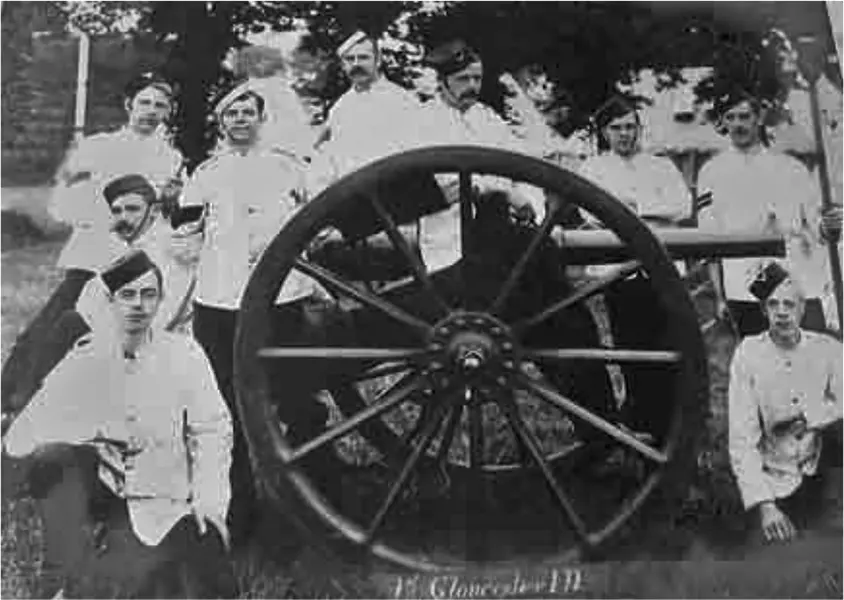
1st Gloucester Gun Detachment Shoeburyness, 1894
Pictured above are Corporal Tyte, Sergeant Warren, Sergeant Lowther, Bombardier Hale, Gunner Balkwill, Corporal Anderson,
Gunner Colman,
Gunner Nichols. Bombardier Horton.
1895 - Captain A. C. Currie was appointed Adjutant vice Captain H.O. Vincent. The Brigade camped at Fort Efford Plymouth, and practiced from office and Bovisand Fort. The Brigade attended a review of the Bristol Volunteers by Major General Sir Richard Harrison K.C.B. C.M.G. R.E. in Ashton Park on the 13th of May. The volunteer decoration for 20 years service was presented to Colonel Savile, Colonel Yabbicom and Captain (Hon. Major) Daniel who was the M.O. for Newent and Gloucestershire Batteries at this review. Honoury Lt. Colonels: Carter and Barge and Surgeon Lt. Col. Lansdown also were awarded the V.D.
1896 - No camp was held this year owing to an outbreak of smallpox in the county of Gloucestershire.
1897 - The Brigade camped at Staddon Heights Plymouth and practiced there. Captain Houldsworth Hunt was appointed Adjutant vice Captain A.C. Currie. At this period the strength was 813 all ranks. On the 22nd of June at the Queen Victoria Jubilee celebrations, the Brigade was represented by a detachment of three officers and 44 other ranks under the command of Major Whitwell. Her Majesty's, Commeration Medals (silver medal for the officer in charge and Bronze for the senior non-commissioned officer) were received.
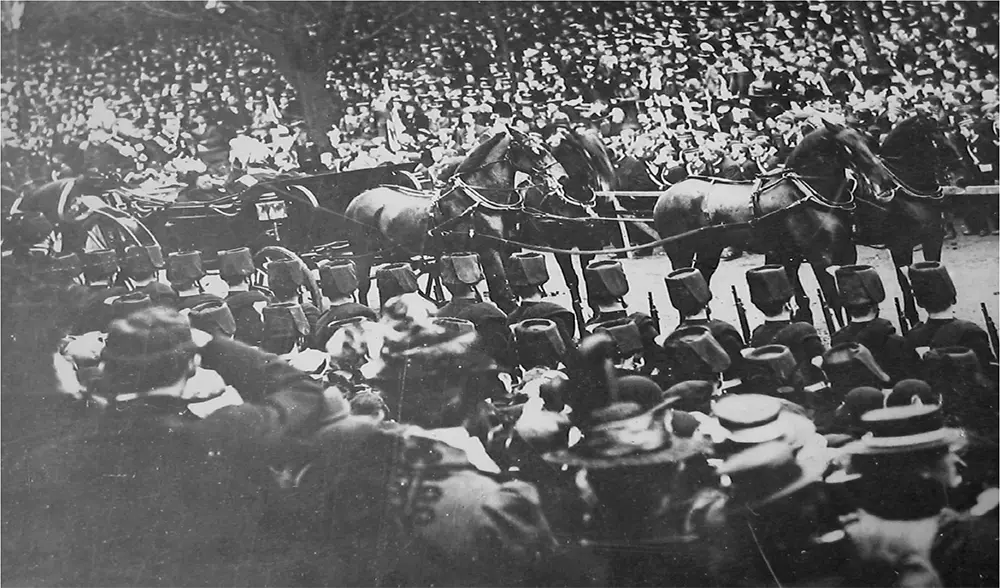
Queen Victoria's Parade, 1897
Note the Busby's been worn by the front and second ranks. and the lack of bayonets, this is because the unit has not had the Freedom of the City and County of Bristol granted to it. Queen Victoria is the small faced lady in the carriage.
23 November 1897 = Colonel. H. T. Yabbicom resigned his commission with permission to retain his rank and wear the uniform after 38 years with the Corps. Colonel Yabbicom was a surveyor for the Bristol City Council and was responsible for the paving and roads. Captain C. H. Cave and (Hon - Major) J. F. R. Daniel resigned.
Winners of the Prince of Wales prize, 2nd Howitzer and Scotland cup. 1895. The Total prize was £140
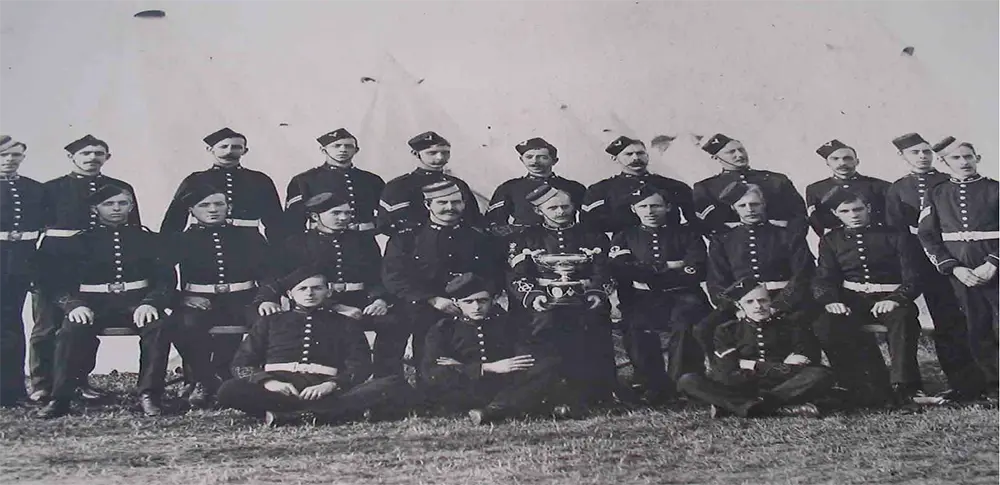
GVA prizewinners 1897
Back line: The prizewinning team were C.S.M. Warren. Gunner Betty, Corporal Sage, Corporal Tyte, Corporal Ridler, Corporal Holloway, Corporal Jeffery, Corporal Gross, Gunner Nichols.
2nd line: Gunner Gould, Captain H. W. K. Waite, C.S.M. Pearce, Corporal Dunscombe, Gunner Davies, Sergeant Anderson.
Bottom line: Gunner Stevens, Bombardier Eyeves, Bombardier Horton.
1898 - The Brigade camped at Fort Efford, Plymouth and carried out practice with Howitzers from Bovisand. The drill was carried out on 8 inch R.M.L.70 and 46 cwt howitzers, 6.6 inch Howitzers and 40 pdr R. M. L. guns on 6 foot parapet carriages. The strength of the Brigade at this time was 797 all ranks.
1899 - The Brigade was rearmed in this year with 60 pounder R.M.L. guns. On the occasion of the visit of her Majesty Queen Victoria to Bristol 30 officers and 588 other ranks attended the parade. The Brigade camped at Staddon Heights. Captain M. Whitwell was promoted major and took over command of No. 1 Company. Lieutenant Woodley was promoted captain and appointed to command No. 4 Company. On the outbreak of the South African War members of the Brigade volunteer for service in the following categories (a) Active Service. (b) Garrison Duty at short notice. (c) A reserve of old members was formed.
20th Century
1900 - The strength of the Brigade at this time was 1,020 all ranks - 1,003 of this number being qualified as efficient. During this year a number of the Brigade transferred to the Imperial Yeomanry and other units for active service in South Africa. Major Weston Stevens O.C. No. 1 Company retired. The Brigade camped at Staddon Heights Plymouth.
Once again in response to petitions to Parliament and the Admiralty concerning the defenceless state of the Bristol Channel the battery at Portishead was re-constructed in 1901. It was located on Portishead Point facing north-west and was specifically intended for the defence of the Bristol Channel leading to the docks at Portishead, Avonmouth and Bristol.
1901 - Captain and Hon. Major K. F. S. Metford were awarded the Volunteer Long Service decoration. The annual camp was held at Staddon Heights, Plymouth and practice was carried out from Bovisand and Crownhill. Ideal weather was experienced for the first part of the week but a lot of heavy rain fell during the remainder of the period. At this period trained men had to complete 6 drills and recruits 15 drills before camp.
1902 - Under a special army order dated 15 January 1902, The official designation of the Corps became 1st. Gloucestershire R.G.A. (Volunteers). Colonel H. B. O. Savile, V.D., honorary Colonel, was appointed to be Companion of the Order of the Bath. No. 1. to No. 6. Coy's, paraded for Coronation celebrations, one officer (Captain Worth), one Sergeant, and eight men attended the Coronation parade in London of H.M. King Edward. The men received 1 x Silver Medal for the Senior officer on parade and 1 x Bronze Medal for the senior NCO on parade. At this period trained men had to complete 15 drills before camp, recruits had to complete 45 of which 20 had to be completed before camp.
1903 - Two 4.7"guns were supplied to the Brigade. Major Wise and C.S.M. Plum awarded Volunteer Long Service Medal.
5 May 1903 - Captain (D.O.) L. Hegarty, R.G.A. was appointed Adjutant, vice captain W.H. Houldsworth Hunt R.G.A.
31 May 1903 - The Brigade camped at Staddon Heights on the 31 May to 6 June.
C.S.M. J.H. Warren, Gunners Lawrence and Ware, awarded Volunteer Long Service Medal
The periodical publication "Broad Arrow" printed very complimentary references to the efficiency of the Brigade and the system of drills in use for 40 years i.e. twice daily 7:15 a.m. and 7:30 p.m. (except Saturday evenings and Sundays) for six consecutive weeks, commencing on the first Thursday after Easter, followed immediately by annual camp.
Captain K.F.S. Metford promoted Major.
Lieutenant H. W. B. Savile joined from 2nd. East Yorks. (Volunteers),
H. White-Smith promoted to 2nd Lieutenant.
By now the 1st Gloucestershire Artillery Volunteers had expanded and in 1904, the H.Q. of No. 13 battery moved from Bedminster to Gloucester.
1904 - Captain W. H. B. Savile commanded No. 4 Coy. vice Captain Forte.
Captain Forte presented a challenge cup for gun drill for all ranks below that of Sergeant.
Sergeant Light, Bombardier Rice and Gunner Cromwell awarded the Volunteer Long Service Medal.
Major Worth retired.
1905- The Brigade camped and carried out their annual practice at Plymouth for this year.
1906 - The Brigade camped and practice at Staddon Heights, Plymouth. Practice carried out with 5 inch and 6 inch B.L. Howitzers.
On 5 June 1906, During practice with the 6 inch 26 cwt Howitzers a premature in the bore occurred with a Lyddite Shell. The piece was completely separated into two parts and the carriage demolished, the wheel of the neighbouring gun was also destroyed. The detachment escaped without serious injuries. The premature was caused by sensitive lead pricrates formed in the shell.
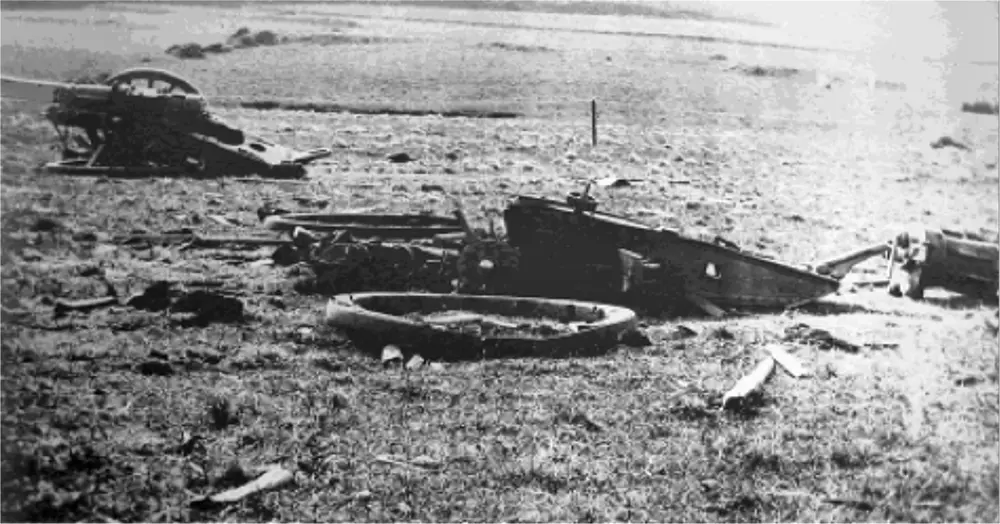
GVA gun accident 1906
Picric acid is an explosive that had been used since 1830 and by 1870 most militaries were using it. In 1891, a chemist named James Dewar, who was working at the Royal Arsenal in Woolwich, England, discovered that adding castor oil to picric acid made it more stable and less sensitive to shock. The resulting explosive material named "Lyddite" after the town of Lydd in Kent, England, where it was first manufactured.
Sometimes extremely unstable explosive metallic salts such as lead picrates could form in the shell causing premature explosions such as the one that destroyed the 6 inch 26 cwt Howitzers gun of the Gloucestershire Volunteer Artillery at Staddon Heights, Plymouth on 5 June 1906.
The following article appeared in "Bay of Plenty Times", Volume XXIV, Issue 3940, 20 December 1899:
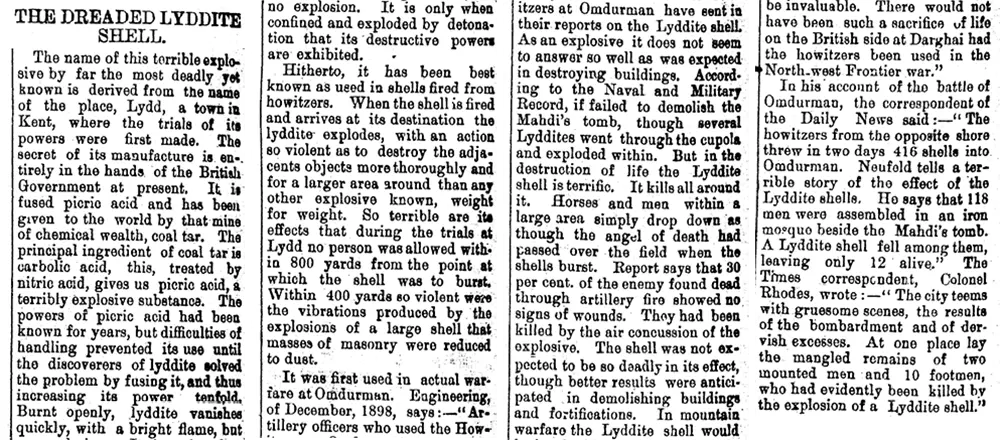
The Dreaded Lyditte Shell, 1899
The articles says:
THE DREADED LYDDITE SHELL
The name of this terrible explosive by far the most deadly known is derived from the name of the place, Lydd, a town in Kent, where the trials of its powers were first made. The secret of its manufacture is entirely in the hands of the British Government at present. It is fused picric acid and has been given to the world by that mine of chemical wealth, coal tar. The principal ingredient of coal tar is carbolic acid, this, treated by nitric acid, gives us picric acid, a terribly explosive substance. The powers of picric acid had been known for years, but difficulties of handling prevented its use until the discoverers of lyddite solved the problem by fusing it, and thus increasing its power tenfold.
Burnt openly, lyddite vanishes quickly, with a bright flame, but no explosion. It is only when confined and exploded by detonation that its destructive power are exhibited.
Hitherto, it has been best known as used in shells fired from howitzers. When the shell is fired and arrives at its destination the lyddite explodes, with an action so violent as to destroy the adjacent objects more thoroughly and for a larger area ground than any other explosive known, weight for weight. So terrible are its effects that during the trials at Lydd no person wag allowed within 800 yards from the point at which the shell was to burst.
Within 400 yards so violent were the vibrations produced by the explosions of a large shell that masses of masonry were reduced to dust.
It was first used in actual warfare at Omdurman [Sudan, 2 September 1898]. Engineering, of December, 1898, says:- "Artillery officers who used the Howitzers at Omdurman have sent in their reports on the Lyddite shell.
As an explosive it does not seem to answer go well as was expected in destroying buildings. According to the Naval and Military Record, it failed to demolish the Mahdi's tomb, though several Lyddites went through the cupola and exploded within. But in the destruction of life the Lyddite shell is terrific. It kills all around it. Horses and men within a large area simply drop down as though the angel of death had passed over the field when the shells burst. Report says that 30 per cent. of the enemy found dead through artillery fire showed no signs of wounds. They had been killed by the air concussion of the explosive. The shell was not expected to be so deadly in its effect, though better results wore anticipated in demolishing buildings and fortifications.
In mountain warfare the Lyddite shell would be invaluable. There would not have been such a sacrifice of life on the British Bide at Darghai had the howitzers been used in the North-west Frontier war."
In his account of the battle of Omdurman, the correspondent of the Daily News said:- "The howitzers from the opposite shore threw in two days 416 she11s into Omdurman. Neufeld tells a terrible story of the effect of the Lyddite shells. He says that 118 men were assembled in an iron mosque beside the Mahdi's tomb. A Lyddite shell fell among them, leaving only 12 alive." The Times correspondent, Colonel Rhodes, wrote:- "The city teems with gruesome scenes, the results of the bombardment and of dervish excesses. At one place lay the mangled remains of two mounted men and 10 footmen, who had evidently been killed by the explosion of a Lyddite shell."
1906 - Four 16pounder R.M.L. guns on the field carriages were issued.
In 1907, the Brigade consisted of 13 batteries, the batteries being distributed as follows:-
Batteries Nos. 1 to 6 at Clifton
Battery No. 7 at Newham
Battery No. 8 at Gloucester
Battery No. 9 at Clevedon
Battery No. 10 at Portishead with a detachment at Bedminster
Batteries Nos. 11 and 12 at Weston-Super-Mare
Battery No. 13 at Bedminster with their H.Q. in Gloucester
1907 - The Brigade camped and practice at Staddon Heights, Plymouth with 15 pounder and 4.7 inch guns.
Captain Wise was promoted Major. The following W. O.'s and N.C.O's on retirement were granted permission to retain their rank and wear the prescribed uniform. Band St., Major Jeffery. C.S.M. H. J. Warren. C.S.M. Ashfield. Sergeant W. J. Hewitt.
His Majesty the King conferred the honour of C.B. on Colonel Ord.
Starting in 1906, the Secretary of State for War, Richard Haldane's Reforms were designed to better prepare the armed forces for future wars and involved a reorganization of the regular, volunteer and militia forces. The Territorial and Reserve Forces Act of 1907 saw the formation of the Territorial Force which consisted of fourteen infantry divisions, fourteen cavalry brigades, and a large number of support units including fully established divisions, provided with field artillery, companies of engineers and crucial supply services, including medical provision. The GVA became part of the Territorial Force, an army tasked with the defence of the UK, and came under the control of the War Office.
The volunteer forces were reformed into a Territorial Force (TF) which had its own organisation and was tasked with the defence of the UK homeland. The TF was organised into divisions that were structured in the same way as the Regular Army, but which were based on geographical regions and soldiers were committed only to home service, that is, were not required to serve overseas except by voluntarily agreeing to do so.
Under Haldene's Reforms, the units became the 2nd South Midland (Gloucestershire) Brigade, Royal Field Artillery (RFA), but this was changed in 1910 to 1st South Midland (Gloucestershire) Brigade, RFA. It formed part of the South Midland Division of the TF, with the following organisation (each battery consisted of four 15-pounder guns):
HQ: Artillery Grounds, Clifton
1st Gloucestershire Battery, Artillery Grounds, Clifton
2nd Gloucestershire Battery, Artillery Grounds, Clifton
3rd Gloucestershire Battery, Barracks, Gloucester
1st South Midland Ammunition Column, Clifton
The GVA was transferred from the Royal Garrison Artillery (RGA) to become part of the Royal Field Artillery (RFA). This meant that coastal defences such as those at Avonmouth and Portishead were manned by the Royal Naval Volunteer Reserve until 1914 when the Portishead battery was dismantled and the stores and ammunition removed.
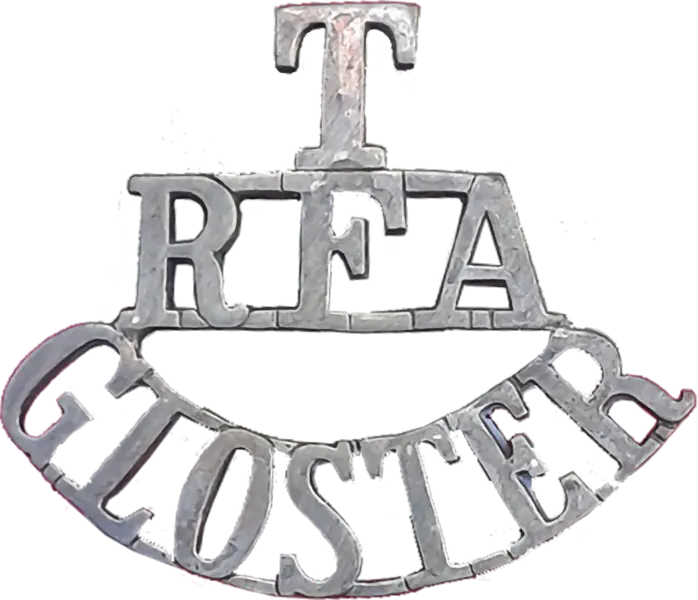
Gloucestershire Territorials Royal Field Artillery white metal shoulder title shoulder title
Also under the Act, the 1st and 2nd Gloucestershire (City of Bristol) Rifle Volunteers became part of the 4th Battalion of the Gloucester Regiment (T), and served as such during the First World War. It was reformed in 1920 and served as an infantry battalion until 1938 when it was re-badged as the 66th Searchlight Regiment RA (TA). After service during the 2nd World War it change it's role and became the 601st (City of Bristol) Heavy Anti Aircraft (Mixed) Regiment RA (TA) in 1947.
The Gloucestershire Volunteer Artillery became the 1st (South Midland) Brigade RFA (T) on 1 April 1908. During the reorganization, the six batteries in Clifton were reformed into 2, with a thrid in Gloucester. An ammunition column was raised with the surplus officers, NCO’s and men in the proportion of 2/3rds at Bristol and 1/3rd at Gloucester.
28 February 1908 - The Corps held a ball at the Victoria Rooms.
31 March 1908 - The Volunteer Force ceased to exist as such and the Territorial Force was established by the Right Honorable R. B. Haldane, Minister for War. Under this scheme, members were to be attested and enlisted for four years and the period for camp increased to 15 Days. The territorial Force was organised in 14 divisions modelled on the lines of a division of the regular army. The Brigade became part of the 7th. District known as the South Midland, which embraced Warwickshire, Gloucestershire, Worcestershire, Oxfordshire, Buckinghamshire and Berkshire.
The total number of troops in the division to be 825 officers, and 20,163 men under the command of Brigadier General H. A. Raitt, C.B. with headquarters at Warwick
On the night of the 31st the volunteer officers held a dinner at the Imperial Hotel, Clifton, and the combined P. O's and Sgts held a dinner at the St Stephen's restaurant, Baldwin Street, to commemorate the termination of the volunteer Force.
During the dinner (at which the Last Post and Reveille were sounded) the Sergeants sent a telegram of greetings to the officers, Colonel Ord in replying expressed a wish to meet them all again in the Territorial Force. All ranks of the Bristol and Gloucester companies enlisted.
"H" Battery R.H.A. visited Gloucester and gave a demonstration to arouse interest. They were entertained by the Mayor in the Guild Hall.
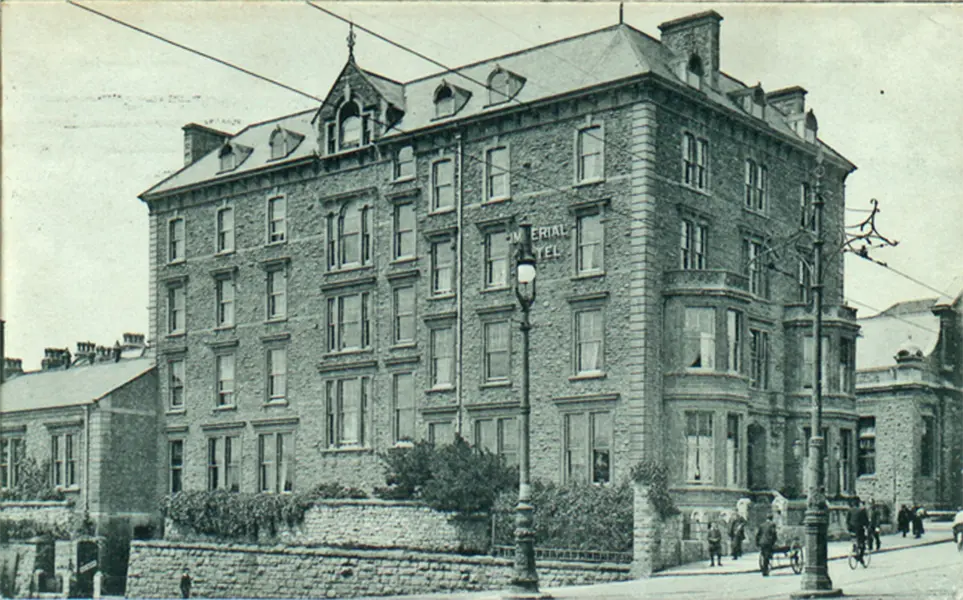
Imperial Hotel, Clifton, Bristol, 1908
Image: Bristol Archives
The Brigade became known as the 1st South Midland Brigade R.F.A. consisting of 1st, 2nd, and 3rd batteries and an Ammunition Column. At first the Brigade was designated 2nd (S.M.) Brigade and the Birmingham Brigade 1st (S.M.) Brigade. R. F. A., this was changed in accordance with the Brigade's seniority.
The new units were made up as follows:-
The 1st Battery
Commanded by Captain (Hon. Major) W. C. Swanye.
No 1. Coy: became number one section.
No 2. Coy: became number two section.
No 4. Coy: became number three section.
The 2nd Battery
Commanded by Major W. H. Wise.
No 3. Coy: became number one section.
No 5. Coy: became number two section.
No 6. Coy: became number three section.
The 3rd Battery
Commanded by Major (Hon. Lt. Colonel). K. F. S. Metford.
No 8. Coy: became No's 1, 2, and 3 sections.
No 13 Coy: became No's 1, 2, and 3 sections.
Ammunition Column
The Ammunition Column under the command of Captain C. N. Todd was formed from surplus officers, N.C.O's. and men in the proportion two thirds, Bristol and have Gloucester. No's 7, 9, 10, 11 and 12 Coy's were disbanded on the 31 March 1908, some members living within the Bristol boundaries were previously transferred to the Bristol companies.
Colonel Ord was appointed to the command of the Brigade with Lt. Col. (Hon: Col.) A. H. Hobbs V.D. as second in command. Battery commanders were appointed as above and other officers posted as follows:-
| 1st Battery | 2nd Battery | 3rd Battery |
| Captain R. D. Austin | Captain C. W. Todd | Captain W. H. Grosvenor |
| Captain H. White-Smith | Captain A. C. St Paul | Captain F. H. Hole |
| Lieutenant G. F. Lefroy | Captain V. A. Hillman | 2nd Lieutenant R. P. P. Lefroy |
| 2nd Lieutenant B. J. James | 2nd Lieutenant E. D. Burbridge | 2nd Lieutenant E. R. Williams |
| 2nd Lieutenant J. R. Chards | 2nd Lieutenant C. K. Cowline | 2nd Lieutenant G. Hartland Bowden |
| 2nd Lieutenant L. H. Abell | 2nd Lieutenant H. G. W. Prideaux | 2nd Lieutenant C. F. H. Priday |
| 2nd Lieutenant K. E. Aitkin |
Captain C. W. Waycott R.F.A. was appointed Adjutant vice Captain Hegarty. R.G.A. in July.
The Brigade was equipped with 15 pdr B.L.C. Guns (four per battery) with the necessary harness and equipment. A large portion of drills was devoted to riding, driving drill and manoeuvres.
Riding classes were held at the Clifton Riding School.
The Brigade camped at Stratton Heights, Plymouth for eight days in June and practised with 15 pounder field guns and 4.7 inch guns.
Capt. (Hon. Major.) C. S. Paul. resigned with permission to retain his rank and wear the prescribed uniform.
31 March 1908 - The following officers resigned Captain A. J. Mawer, Captain W. A. B. Savile, Captain W. J. W. Dickman, and Surgeon Captain A. Ogilvy. M.D.
1 April 1908 - Surgeon Captains W. J. Hill and J.R. Bibby. M.B. posted to the Brigade.
9 June 1908, the Brigade furnished a guard of honour and fired the Royal Salute on the visit of H. M. King Edward VII and took part in a tournament.
The silver gun Trophy hitherto awarded for Carbine shooting was awarded to the best all round battery.
Sergeant M. G. V. P. Wills commissioned 2/nd Lt. he would later become Sir Vernon G. P. Wills.
August 1908 - Gold braid and badges substituted for the Volunteer Silver pattern badges August 1908.
Surgeon Lieutenant Colonel (Hon: Surg. Col.) J. S. Carlton resigned with permission to retain his rank and wear the prescribed uniform.
23 November 1908 - Captain W. W. Grosvenor resigned his commission
Sources and Resources
Derek Driscoll's original pages
Historical-Records-1859-1914 (PDF, 3.64Mb)
Historical Records of 66th (South Midland) Field Brigade R.A. (T.A.)
Historical Records of 66th (South Midland) Field Brigade R.A. (T.A.)
The Bristol Gunner Tradition by Major J. Smith RA (V) MBE TD
The Bristol Gunner Tradition (Image) by Major J. Smith RA (V) MBE TD
The Bristol Gunners - History
Derek Driscoll's References
Derek made use of several sites while creating his, the main ones were:
British Artillery
The Long, Long Trail
Other Resources
A military history of Bristol during the Revolutionary War 1793-1802 - John Penny, Fishponds Local History Society
Arrowsmith's Dictionary of Bristol 1884 - edited by H. J. Spear and J. W. Arrowsmith
Clifton and Durdham Downs: A Place of Public Resort and Recreation by Gerry Nichols, Bristol Branch of the Historical Association, 2006
Gloucestershire Volunteer Artillery - by Wienand Drenth, T. F. Mills
Gloucestershire Volunteers 1795-1815 - Brigadier H. Bullock, Journal of the Society for Army Historical Research , June, 1960, Vol. 38, No. 154 (June, 1960), pp. 76-82
Imperial Hotel Clifton, 24th Apr 1908 - Bristol Archives
Invalid Battalion, Royal Artillery - Steve Brown
Lead picrate - Wikipedia
Modern Munitions of War - Nature, July 29, 1915
National Artillery Association
Picric acid - Wikipedia
Rough Notes on the Portishead & Avonmouth Coastal Gun Batteries 1643 to 1945 - Flying Fox Association
Shell (projectile) - Wikipedia
The Dreaded Lyditte Shell - Bay of Plenty Times, Volume XXIV, Issue 3940, 20 December 1899, Page 2
The Volunteer Artillery 1859-1908 by Norman Litchfield and Ray Westlake, Sherwood Press
Volunteer Force - Wikipedia
